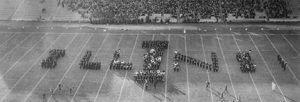
In mid-October, 1907, the Illinois Regimental Band, later to become the Marching Illini in the 1950s, made band and sports history by performing what is believed to be the first marching band football halftime show. Under the leadership of the Director of Bands, Albert Austin Harding, the band took the field during the football season opener against the University of Chicago. The bands performance included the “Block I” formation, still a staple of the band today. This performance started the national tradition of the marching band halftime show.
The halftime show was a product of the innovative leadership of Harding, who was appointed as the director the band department, the first at an American university, in 1907. Harding wasted no time in making more history, creating his halftime show that same year. During his time as director, Harding worked to expand the University Band’s role in campus life, including through the halftime show.

This was not the first time the band performed at a sporting event. The band had previously been performing at baseball games, as well as playing from the stands at football games, so spectators were used to, and greatly enjoyed, having the band play. The 1907 game was the first marching field show the band had performed at a football game.
While the October 19, 1907 football game marked an important first for the University of Illinois, spectators may not have felt as excited. The university suffered a crushing defeat from the University of Chicago, 42 – 6. For many people in Urbana-Champaign, it may have not seemed like a proud day for the university at all.
What those present at the game could not have known at the time was that they had seen the birth of a tradition that would spread across the country. Almost every American who has been to a high school or college football game is familiar with watching the school marching band play. Many can easily imagine the patter of the drumline warming up, the sight of the shapes formed by the band on the football field, and the school pride inspired by the performance.
– Illinois Field. This is where the 1907 halftime show occurred before the football team moved locations. Illinois Field was a baseball, football and track field. It was located between Wright Street and Mathews Avenue and Springfield Avenue and University Avenue. The North Quad currently occupies this space.
– Sousa Archives and Center for American Music. 1103 S 6th St, Champaign, IL 61820, for historical documents related to Albert Austin Harding
Burford, Cary Clive. We’re loyal to you, Illinois; the story of the University of Illinois bands under Albert Austin Harding for 43 years, superimposed upon glimpses of university history during the half-century of Harding leadership on campus (1954). Danville, Ill., The Interstate. Retrieved from http://hdl.handle.net/2142/44628
Evensen, D. (2017, October 20). Big Beats. Retrieved from https://illinoisalumni.org/2017/10/20/band-lessons-the-marching-illini-story/
Football Game (2). (1932). Photographic Subject File. Record Series 39/2/20, Box 148, Folder MUS – 3 1930 – 35. University of Illinois Archives.
A. Austin Harding Papers. (1895-1958). Record Series 12/9/22. University of Illinois Archives.
Marching Illini. (n.d.). History of the Marching Illini. Retrieved from http://marchingillini.com/tradition/
U of I Concert Band at Homecoming Game. (1922). Photographic Subject File. Record Series 39/2/20, Box 148, Folder MUS – 3 1912 – 29. University of Illinois Archives.
